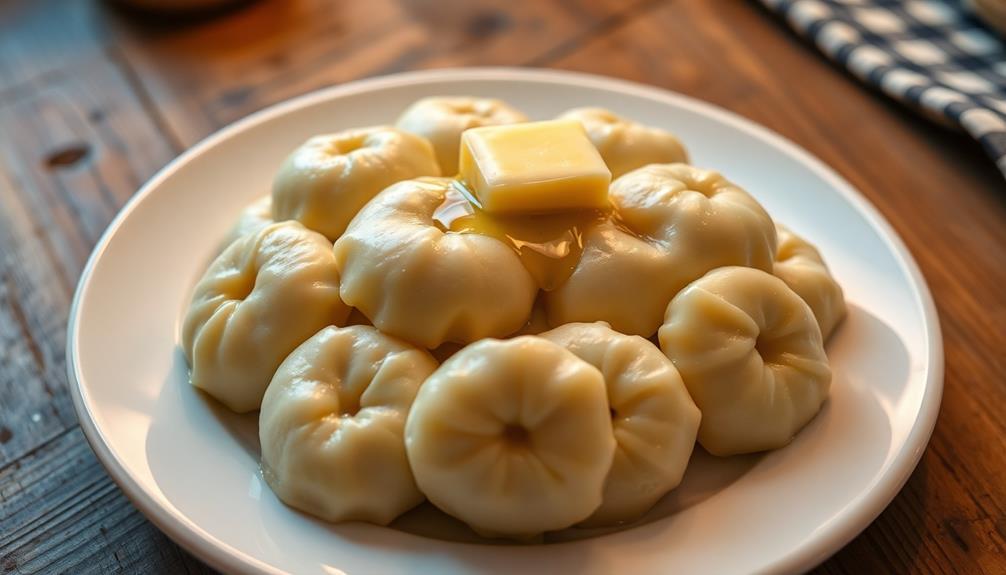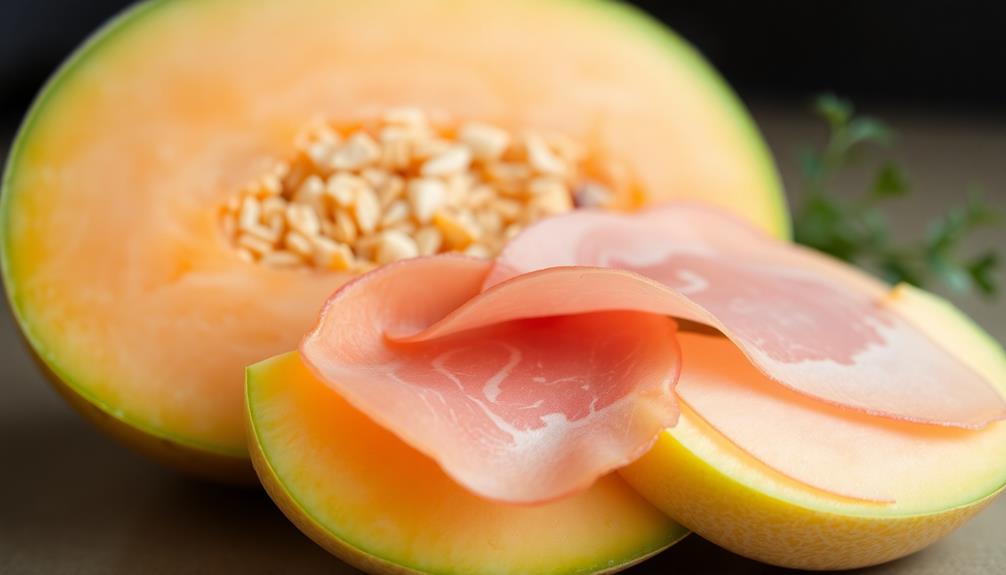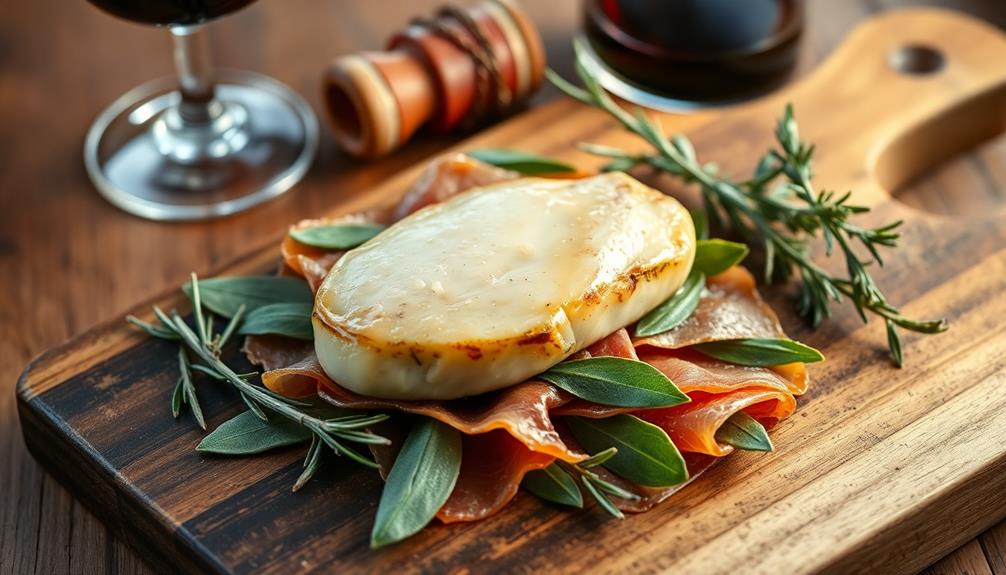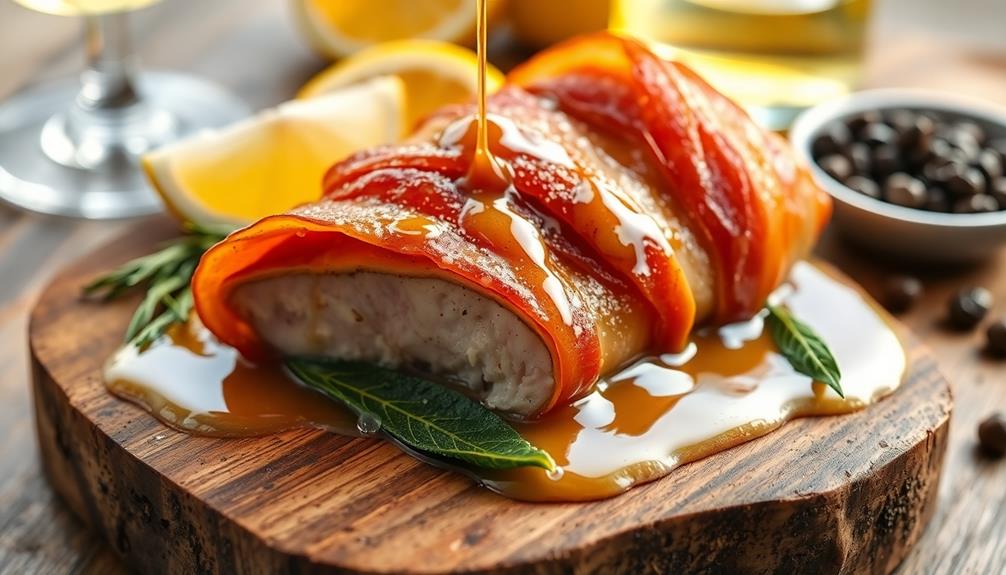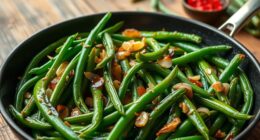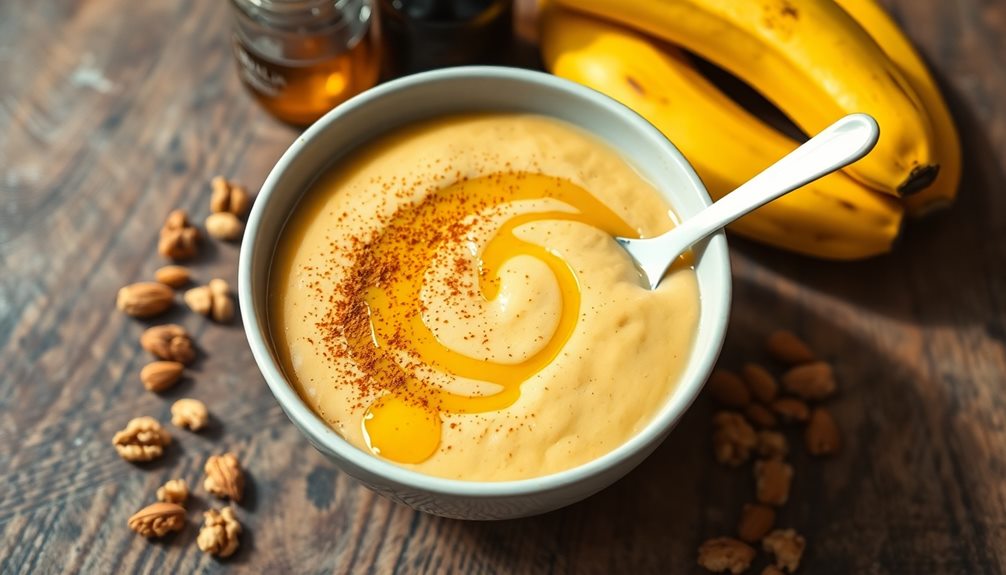Panna cotta is a delicious Italian dessert that you'll love! It's made with cream, milk, sugar, and gelatin, resulting in a silky-smooth treat. You can easily make it at home with just a few ingredients. The best part? You can flavor it however you like! Try adding vanilla, coffee, or fruit for a tasty twist. To serve, unmold it onto a plate and add your favorite toppings. Fresh berries, caramel sauce, or whipped cream are great choices. It's perfect for family gatherings or fancy dinners. With its creamy texture and endless possibilities, panna cotta is sure to become your new favorite dessert. Keep exploring to discover the secrets of this Italian delight!
Key Takeaways
- Panna cotta is an Italian dessert made primarily from cream, milk, sugar, and gelatin.
- It originated in the Piedmont region of Italy in the early 20th century.
- The dessert has a silky, smooth texture and is typically molded before being unmolded for serving.
- Popular variations include vanilla, coffee, and fruit flavors, often served with toppings like berries or caramel.
- Panna cotta is easy to prepare, can be made ahead of time, and is suitable for various occasions.
History
Although its exact origins are debated, panna cotta's roots can be traced to the Piedmont region of Italy in the early 20th century. This creamy dessert quickly became a favorite among locals and visitors alike.
You'll be delighted to know that panna cotta's popularity spread like wildfire throughout Italy!
As you explore the history of this delicious treat, you'll discover that:
- It's believed to have been created by a Hungarian woman in the Langhe area of Piedmont.
- The name "panna cotta" means "cooked cream" in Italian.
- It was traditionally made with cream, milk, sugar, and fish bones for gelatin.
Over time, panna cotta evolved and became a staple in Italian cuisine.
You'll find that modern recipes often use:
- Vegetarian gelatin alternatives
- Flavored variations like vanilla, coffee, or fruit
- Creative toppings and sauces
Today, you can enjoy panna cotta in restaurants worldwide.
It's a versatile dessert that's perfect for family gatherings, holidays, and special occasions.
You'll love how easy it's to make at home, too!
Recipe
Panna cotta is a classic Italian dessert known for its silky smooth texture and delicate flavor. The name literally means "cooked cream" in Italian, but despite its elegant appearance, it's surprisingly easy to make at home. This versatile dessert can be flavored in countless ways and pairs beautifully with fresh fruits or sauces. For a simple but impressive dinner party menu, consider serving panna cotta as the perfect ending to a meal featuring classic Italian dishes like homemade lasagna recipe. The creamy, indulgent texture of the panna cotta provides a lovely contrast to the savory, comforting flavors of the lasagna. With a little preparation and creativity, you can easily recreate a taste of Italy in your own kitchen. To elevate your Italian-themed dinner even further, you can pair the panna cotta with seasonal treats like panettone traditional Italian Christmas cake during the holiday season. The light and airy texture of the panettone perfectly complements the creamy richness of the panna cotta, offering guests a delightful combination of flavors and textures. Whether served alongside each other or with a drizzle of fruit compote, these two desserts create a memorable and delicious finish to any festive gathering.
This recipe creates a traditional vanilla panna cotta, which serves as an excellent base for experimenting with different flavors and toppings. The key to achieving the perfect panna cotta lies in getting the right balance of gelatin to cream, ensuring a wobble that's firm enough to hold its shape but still tender and creamy when eaten.
- 2 cups heavy cream
- 1 cup whole milk
- 1/3 cup granulated sugar
- 2 teaspoons vanilla extract
- 2 1/4 teaspoons unflavored powdered gelatin
- 3 tablespoons cold water
In a medium saucepan, combine the cream, milk, and sugar. Heat over medium heat, stirring occasionally, until the sugar dissolves and the mixture is hot but not boiling. Remove from heat and stir in the vanilla extract.
In a small bowl, sprinkle the gelatin over the cold water and let it sit for 5-10 minutes to bloom. Add the bloomed gelatin to the warm cream mixture and stir until completely dissolved. Strain the mixture through a fine-mesh sieve into a large measuring cup or bowl with a spout. Divide the mixture among 4-6 ramekins or molds. Refrigerate for at least 4 hours or overnight until set.
For best results, use high-quality ingredients, especially when it comes to the cream and vanilla. To easily unmold the panna cotta, briefly dip the ramekins in hot water before inverting onto a plate.
If you prefer a lighter version, you can substitute some of the cream with milk or half-and-half. Experiment with different flavors by infusing the cream with spices, coffee, or citrus zest, or try layering the panna cotta with fruit purees for a striking visual effect.
Cooking Steps
Let's get started with making your panna cotta!
You'll begin by blooming gelatin in cold water, then heat cream and sugar together.
Next, you'll add vanilla and the gelatin mixture, stirring until everything's well combined.
Step 1. Bloom Gelatin in Cold Water

To begin the panna cotta-making process, you'll need to bloom the gelatin. This step is crucial for getting that perfect, velvety texture we all love in our desserts. Here's how you'll do it:
- Pour cold water into a small bowl
- Sprinkle the gelatin powder evenly over the water's surface
- Let it sit for about 5 minutes
While you're waiting, you'll see something magical happen! The gelatin will start to absorb the water, swelling up like a sponge. It's so cool to watch!
This process is called "blooming," and it's what gives your panna cotta its wonderful, jiggly consistency.
Once your gelatin has bloomed, it's ready to use in your recipe. Remember, never add hot liquid directly to the bloomed gelatin. That can make it clump up, and nobody wants lumpy panna cotta!
Instead, you'll gently warm it with your other ingredients.
Step 2. Heat Cream and Sugar

After blooming the gelatin, you'll move on to heating the cream and sugar. This step is where the magic begins! Grab a medium-sized saucepan and pour in your heavy cream. Add the sugar and give it a good stir. Now, it's time to turn up the heat!
Place the saucepan over medium heat and keep stirring gently. You'll want to heat the mixture until it's hot, but not boiling. Here's what to look out for:
- Small bubbles forming around the edges of the pan
- Steam rising from the surface
- The sugar completely dissolving
As you heat the cream and sugar, you'll notice a sweet aroma filling your kitchen. It's like a warm hug for your nose!
A cleaner indoor environment may enhance your cooking experience, as improved air quality can contribute to overall well-being and health benefits, including a reduction in allergens and respiratory irritation improved air quality.
Keep stirring to prevent the mixture from sticking to the bottom of the pan. This process usually takes about 5-7 minutes, but don't rush it.
Once the cream is hot and the sugar has dissolved, you're ready for the next exciting step in creating your delicious panna cotta. Remember, patience is key in making this creamy Italian dessert!
Step 3. Add Vanilla and Gelatin

The moment of truth arrives as you prepare to infuse your panna cotta with rich vanilla flavor and set it to perfection. As you carefully pour the fragrant vanilla bean-infused cream into the waiting molds, you can almost taste the creamy, silky texture of the finished dessert. You place the panna cotta in the refrigerator, eagerly anticipating the moment when you can savor the luscious result. In the meantime, you decide to whip up a popular South Indian breakfast dish, dosa, to enjoy with your creamy panna cotta later.
It's time to add the star ingredients that'll transform your cream mixture into a silky-smooth dessert!
Here's what you'll need to do:
- Remove the vanilla bean from its pod and scrape out the seeds.
- Add both the seeds and the empty pod to your warm cream mixture.
- Stir gently to distribute the vanilla evenly.
Now, let's tackle the gelatin:
- If you're using powdered gelatin, sprinkle it over cold water in a small bowl.
- Let it sit for a few minutes to "bloom" (absorb the water).
- If you're using gelatin sheets, soak them in cold water until they're soft.
Once your gelatin is ready:
- Remove the vanilla pod from the cream mixture.
- Add the bloomed gelatin to the warm cream.
- Stir continuously until the gelatin dissolves completely.
You're almost there!
The vanilla's heavenly aroma will fill your kitchen, and the gelatin will work its magic to give your panna cotta that perfect, wobbly texture.
Get ready for a treat that'll make everyone smile!
Step 4. Pour Into Molds

Your panna cotta's journey from liquid to luscious dessert begins with this crucial step. It's time to pour your creamy mixture into molds and watch the magic unfold!
Here's what you'll need to do:
- Choose your molds:
- Ramekins
- Silicone molds
- Glass cups
- Fancy dessert glasses
- Prepare the molds:
- Lightly grease them with oil
- Or leave them as-is for a rustic look
- Pour the mixture:
- Use a ladle or measuring cup
- Fill each mold about 3/4 full
- Leave room for toppings later
- Smooth the top:
- Gently tap the molds on the counter
- This removes air bubbles
- Cover and chill:
- Use plastic wrap or foil
- Place in the refrigerator for at least 4 hours
Step 5. Chill and Unmold Desserts

Anticipation builds as your panna cotta sets in the refrigerator. Let it chill for at least 4 hours, or overnight if you can wait that long! The patience pays off when you're ready to serve this creamy treat.
When it's time to unmold, here's what you'll do:
- Fill a bowl with warm water
- Dip the mold in for about 3 seconds
- Run a thin knife around the edge to loosen it
- Place a plate on top and flip it over
- Gently shake to release the panna cotta
Voila! Your dessert should slide out smoothly. If it's stubborn, try another quick dip in warm water.
Now comes the fun part – decorating! Here are some tasty topping ideas:
- Fresh berries or sliced fruit
- A drizzle of caramel or chocolate sauce
- A sprinkle of chopped nuts
- A dollop of whipped cream
Get creative and make it your own! Kids love helping with this step.
It's a great way to get the whole family involved in making a special dessert. Enjoy your homemade panna cotta – it's sure to be a hit at any gathering!
Final Thoughts
After exploring the delightful world of panna cotta, it's clear why this Italian dessert has captured the hearts of food lovers worldwide.
Its silky texture and endless flavor possibilities make it a perfect treat for any occasion. Whether you're hosting a fancy dinner party or just craving something sweet, panna cotta is sure to impress.
Here are some reasons why you'll love making panna cotta:
- It's easy to prepare, even for beginners
- You can make it ahead of time
- There are countless flavor combinations to try
- It's a great alternative to heavy desserts
Remember, the key to a perfect panna cotta is in the details.
Don't rush the process, and always use high-quality ingredients. With practice, you'll become a pro at creating this heavenly dessert.
Frequently Asked Questions
Can Panna Cotta Be Made Dairy-Free?
Yes, you can make dairy-free panna cotta. You'll need to substitute dairy ingredients with plant-based alternatives like coconut milk or almond milk. You can also use agar-agar instead of gelatin for a vegan-friendly version. It's surprisingly easy to adapt!
How Long Does Panna Cotta Last in the Refrigerator?
You'll find that it lasts about 3-5 days in your fridge. Make sure you cover it tightly with plastic wrap to prevent it from absorbing other flavors. It's best consumed within the first 2-3 days for optimal taste.
Is It Possible to Freeze Panna Cotta?
Yes, you can freeze panna cotta, but it's not ideal. You'll notice changes in texture and consistency when thawed. If you must freeze it, wrap it tightly and consume within a month for best results.
What Are Some Common Flavor Variations for Panna Cotta?
You'll find many delicious flavor variations for this dessert. Try vanilla, chocolate, or fruit-infused versions like strawberry or lemon. You can also experiment with coffee, caramel, or even savory options like basil or saffron.
Can Panna Cotta Be Unmolded Without Using Gelatin?
You can unmold a gelatin-free panna cotta using alternatives like agar-agar or carrageenan. These plant-based gelling agents work well, but you'll need to adjust the ratios. They'll set firmer than gelatin, so be careful when unmolding.

